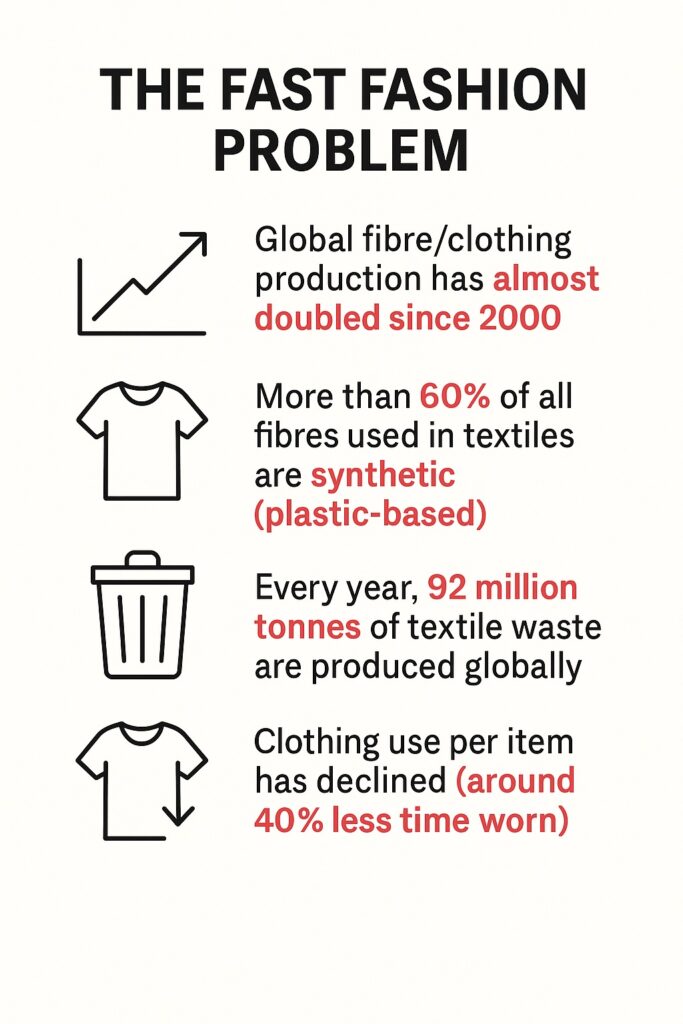There is a conversation happening across every creative industry right now. AI is replacing human talent. It is taking over jobs. It is reshaping entire fields. People are talking about what this means for artists, designers, musicians, and writers.
But almost no one is talking about what it means for fashion.
AI is now able to replicate patterns, textures, motifs, and weaving styles that took real artisans entire lifetimes to master. It can study centuries of craft in seconds and recreate it without the people who built those traditions. This is happening at the exact same time that fast fashion is flooding the market with cheap synthetic clothing.
The result is a quiet crisis. Traditional textile techniques are disappearing. Many are becoming endangered. Not because they lost relevance, but because our fashion system is replacing them with faster, cheaper, automated outputs.
Overconsumption created the problem, and now AI is accelerating it.
This is the real story. Our buying habits and our new technology are pushing cultural craftsmanship to the edge of extinction.
Fast Fashion, AI, and the Collapse of Textile Heritage
To understand why this is happening, we have to look at the bigger picture.
Global clothing production keeps increasing. It has doubled since 2000.
We are wearing each piece significantly less than we used to. About 40 percent less.
The world throws away 92 million tons of textile waste every year. That is a new mountain of clothing every single second.
At the same time, more than 60 percent of all fabric we buy is synthetic. It is made from plastic fibers like polyester and nylon. These materials are fast to produce and easy to print on. They also replace natural, handwoven, and culturally unique textiles everywhere.
Now add AI to this mix.
AI can generate ikat patterns.
AI can simulate Kente variations.
AI can recreate Andean motifs.
AI can print “handwoven style” graphics that look similar enough to pass in mass markets.
The consumer sees a pattern they recognize from a culture. The price is low. The production is fast. The meaning is removed. And the artisan who originally created that technique is left out entirely.
UNESCO reports that traditional crafts are disappearing faster than almost any other cultural practice. AI, automation, and mass production are accelerating that trend.
In India, mechanization has already displaced large artisan communities. In Kashmir alone, the shift to power looms has threatened the livelihoods of more than 500,000 people who depend on traditional pashmina weaving.
No one is talking about how AI is making it worse.
The Traditional Textiles That Are Becoming Endangered
Ikat and Handloom Weaving in India
- Ikat requires dyeing threads with exact precision before weaving.
- A single sari can take weeks to complete.
- AI and automated printing can now create ikat-style patterns in minutes.
- Synthetic replicas sell at a fraction of the cost, undercutting artisans.
Kasuri and Boro in Japan
- Kasuri uses pre-dyed threads similar to ikat, requiring years of training.
- Boro is a cultural repair and reinforcement technique rooted in necessity and care.
- These traditions now survive mostly in museums and luxury craft spaces.
- Very few artisans practice them consistently today.
- AI tools can imitate these patterns instantly.
Kente and Adire in West Africa
- Kente cloth carries symbolism, storytelling, and community identity in Ghana.
- Adire is a Yoruba resist-dyeing tradition passed down for generations.
- Both are increasingly replaced by mass-produced, synthetic textiles.
- AI-generated pattern libraries make imitation easier for brands seeking the look without the craft.
Backstrap Weaving in Peru and Bolivia
- Andean women have used backstrap looms to weave cultural stories for centuries.
- Tourism markets and imported fast fashion have disrupted local demand.
- Young artisans face economic pressure to leave weaving behind.
- AI-driven pattern scraping makes copying these designs even more widespread.
These textiles are more than fabric. They are language, skill, memory, and culture, and they are becoming increasingly vulnerable.
How Overconsumption and AI Are Quietly Pulling Craft Apart
Most people are buying clothes faster than they can even keep track of them. New trends show up every week. There is always a sale. There is always a new drop. And when fashion moves that fast, handmade craft simply does not stand a chance.
Traditional weaving and dyeing used to set the pace. Now the pace is set by whatever can be produced the quickest. Artisans who once spent years perfecting their skill now compete with a machine that can print a similar pattern before lunch.
And the newest competitor in the room is AI. It does not just copy patterns. It copies the style, the history, the symbolism, and the look of entire cultures in seconds. It studies a lifetime of craft and produces an imitation before an artisan even wakes up in the morning.
This changes everything. Consumers get used to seeing “handmade style” prints for a few dollars, and once that expectation settles in, people stop noticing what authentic craft really looks like. Or worse, they believe a computer version is close enough.
That makes survival incredibly hard for the people who learned these skills from their grandparents, who grew up with looms in their homes, who weave because it is part of their identity. Many are leaving the work entirely because they cannot compete with the speed of fast fashion or the accuracy of AI.
Governments rarely step in, since industrial growth brings in more money than slow craft work. So these communities end up standing alone while machines, automation, and AI move in around them.
And this is the part of the AI conversation that almost never comes up. Everyone talks about how AI affects designers or writers or photographers. Very few people talk about how it affects the people who protect cultural craft. But it is happening in real time, and it is changing the future of textiles more quietly than any other industry.

How Slow Fashion Can Bring These Traditions Back to Life
Here is the good news. Slow fashion is not just a trend, it is one of the few things keeping traditional textiles from disappearing completely.
There are brands out there that refuse to take shortcuts. They do not copy a pattern they found online. They do not use AI to recreate someone’s heritage. Instead, they sit with artisans. They listen. They collaborate. They build relationships. Brands like Behno, Maki Oh, and Patine show that fashion can be modern and still respect the people who make it possible.
There are also organizations that step in when governments will not. UNESCO (United Nations Educational, Scientific and Cultural Organization), Nest, and the Crafts Council UK help artisans get fair pay and connect them to buyers who actually understand the value of what they do. It is not charity. It is about giving people the support they deserve for keeping culture alive.
What is really beautiful is that most traditional techniques are already sustainable without trying to be. Handloom weaving uses a fraction of the energy that a factory uses. Natural dyes come from the earth instead of chemical vats. These systems existed long before sustainability became a marketing word, and they show us what fashion could look like if we slowed down.
Craft is also a lifeline for women in many rural communities. When you support a handwoven scarf or a naturally dyed textile, you are supporting entire families. You are helping keep a skill alive. You are making it possible for someone to pass that skill down to the next generation instead of watching it disappear.
And revival is possible. Khadi in India is such a good example. A few years ago, very few people outside India were talking about it. Then interest in sustainable textiles started growing, and Khadi came roaring back. Sales increased. Young people started learning the craft again. Consumers demanded something more meaningful, and the industry responded.
This is what can happen when people slow down and choose intentionally. Craft does not just survive. It comes back stronger.
How You Can Support Traditional Textiles Without Feeling Overwhelmed
Small choices make a real difference.
For shoppers
- Buy less and choose better.
- Look for artisan-made labels such as WFTO Fair Trade, Nest Seal, or Handwoven India.
- Choose natural fibers including cotton, linen, silk, and hemp.
- Value the small imperfections in handmade pieces. They show real human work.
- Share the story behind your clothing. Awareness creates protection.
For brands and designers
- Credit artisans clearly.
- Partner with craft communities.
- Pay fairly.
- Replace “inspired by” with “created with.”
- Support policies that protect traditional textile techniques.
Every action matters.
Why Protecting Traditional Textiles Matters for Fashion’s Future
Traditional textiles are not outdated. They are cultural memory, identity, and sustainable knowledge. They prove that fashion can be slow, thoughtful, and connected.
Every disposable trend piece pulls a thread from these stories. Every artisan-made piece adds one back.
Protecting these crafts is not about nostalgia. It is about climate responsibility, cultural survival, and the future of creativity itself. AI may be powerful, but it cannot replace human connection, human skill, or human storytelling.
Fashion can honor its past instead of erasing it. It starts with what we choose to value, purchase, and support.

Follow me on my socials:
- Instagram: @lexysilverstein
- Youtube: Lexy Silverstein
- Twitter: @eLEXYfy
- TikTok: @lexysilverstein
- Facebook: Lexy Silverstein
- Liketoknow.it/lexysilverstein
You can email me at LexySilverstein@gmail.com




